A living Christmas tree is perhaps the most eco-friendly option for those who like to grow plants and make lasting family memories. They bring the wonderful, woodsy smells of the forest indoors, brighten up porches and patios, and look downright magical when dressed in battery-powered, automatic fairy lights. The best part? When the holidays wind down, these trees can be planted in the landscape where they can be lit and decorated for years to come, becoming part of your family’s seasonal traditions.
Living Christmas trees also make thoughtful gifts that keep on giving. Once planted outdoors, they offer far more than holiday cheer: they provide evergreen structure, year-round habitat and food for birds and wildlife, and help support a more resilient, ecologically vibrant landscape.
Most of the plants recommended below are native to Texas or extremely well-adapted to our region, meaning they thrive in our challenging clay soils and handle our dramatic temperature swings with ease. And if you want to enjoy that fresh evergreen scent inside for a bit, many of these trees will be perfectly happy for a few weeks indoors—all you need is a bright, sunny window.
While there are quite a few “Christmasy” plants marketed as “living” Christmas trees, most are (unfortunately) not adapted to our soil and climate—at least not if the end goal is to plant the tree outside. SO calling them “living” is a stretch. While techincally they might be alive now– the reality is they would soon be dead if planted outdoors in North Texas, and because they are not well suited to be grown indoor for very long– they are a poor use of both our financial and natural resources.
Unfortunately, big-box stores, grocery chains, and most nurseries that don’t specialize in Texas-adapted plants sell these “living Christmas trees” as if they’re landscape-ready—when in reality, most will almost certainly decline or die once planted outdoors in North Texas.
The most common living Christmas “tree,” for sale at nearly every major retailer, is the Norfolk pine. While they can live indoors as a tabletop tree for a few years, they can’t handle the extreme volatility of our Texas climate once planted outside.
To help separate fact from festive fiction, here are the most common “living Christmas trees” that won’t survive outdoors in North Texas—and why.
1. Norfolk Island Pine — Araucaria heterophylla
Why it fails: A tropical species that cannot tolerate Texas freezes or our rapid temperature swings.
2. Lemon Cypress / “Lemon Cedar” / ‘Goldcrest’ Cypress — Cupressus/Chamaecyparis macrocarpa ‘Goldcrest’
Why it fails: Very sensitive to heat and humidity; prone to root rot in our alkaline, heavy clay soils.
3. Dwarf Alberta Spruce (“Tabletop Spruce”) — Picea glauca ‘Conica’
Why it fails: Requires cool, low-humidity climates; Texas summers cause intense heat stress and spider mite infestations.
4. Italian Stone Pine — Pinus pinea
Why it fails: A Mediterranean species that struggles with Texas humidity, winter cold fronts, and poorly drained clay soils.
5. Mini Spruces / Mini Firs / Generic “Holiday Trees” — Picea, Abies, Tsuga, Cryptomeria
Why they fail: Most are mountain- or northern-climate conifers that cannot tolerate Texas heat, drought stress, or alkaline soils. Short-lived outdoors.
The good news: there are plenty of evergreen trees that are well-adapted to North Texas, look and smell like Christmas, and make excellent long-term landscape additions. Whether kept indoors for a festive spell or planted straight into the ground, these trees provide habitat for wildlife, structure for the landscape, and—when planted on the north side of the home—can even take the bite out of winter cold fronts.
Below are the classics from the original list, plus all your new additions integrated cleanly.
Keeping these Texas-native and adapted living trees, actually living indoors is not without it’s limitations, however. Long-term most want full sun and are happiest indoors for only 3–4 weeks. Placing them in either South- or West-facing windows work best. Water sparingly — but consistently — and ensure excellent drainage. These plants are VERY drought tolerant and hate standing in water. Be sure to let the top of their soil dry out between each watering.
If you don’t have great indoor light, keep the tree outdoors in its pot and decorate with battery-powered lights and birdseed ornaments for a natural, wildlife-friendly holiday vibe.
Juniperus scopulorum ‘Wichita Blue’
Silver-blue foliage • 10–15′ tall • 4–6′ wide
A cultivar of our native Rocky Mountain juniper, with rich blue foliage and excellent adaptation. Host plant to the olive hairstreak butterfly. Great indoors for up to a month, then plant in full sun, slightly above grade with compost or expanded shale.
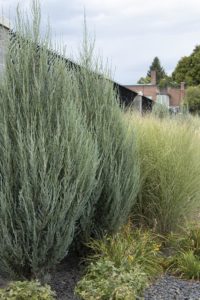
Juniperus scopulorum ‘Skyrocket’
Blue-green foliage • 15–20′ tall • 2–3′ wide
One of the narrowest evergreens on the market. A female selection that produces blue berries beloved by birds. Great in screens or vertical accents.
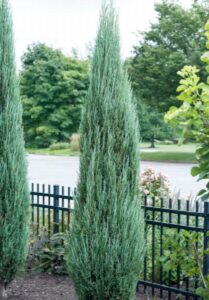
Juniperus scopulorum ‘Blue Arrow’
Blue-green foliage • 12–15′ tall • 2–3′ wide
Another upright, narrow cultivar perfect for porch displays and later planting in well-drained full sun. Excellent for wind screens and wildlife.
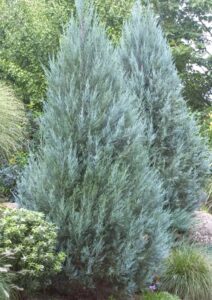
Juniperus scopulorum ‘Moonglow’
Silvery blue foliage • 15–20′ tall • 6–8′ wide
A standout among blue junipers, with icy, luminous foliage that reads as “mountain Christmas tree.” Tough, fast-growing, and drought-tolerant — perfect for screens, anchors, or statement specimens.

Cupressus arizonica
Sage-blue foliage • 20–30′ tall • 8–12′ wide
For that “naturally flocked” look. Wonderfully fragrant indoors; thrives outdoors in full sun with excellent drainage. Bark exfoliates in shades of red, plum, and copper.
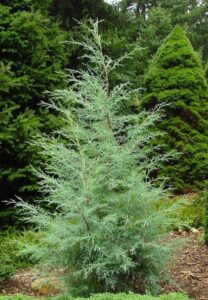
Cupressus arizonica ‘Quick Frost’
Blue-frosted foliage • 15–20′ tall • 6–10′ wide
A compact, denser, more color-intense selection. Perfect for smaller yards or lovers of that frosted-silver holiday look.
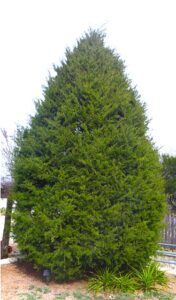
Juniperus virginiana
Dark green foliage • Up to 50′ tall • 25′ wide
A true Texas native with natural Christmas-tree form. Great for wildlife habitat, wind protection, and structure in larger landscapes.

Juniperus virginiana ‘Brodie’
Rich green foliage • 25′ tall • 6–8′ wide
A narrow, upright form with excellent color and texture. Ideal for hedges, screens, and tight spots needing that classic conical silhouette.
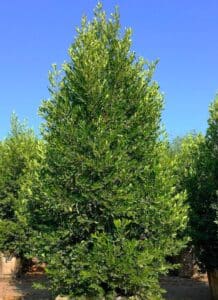
Prunus caroliniana ‘Bright ’n Tight’/‘Everbright’
Glossy green foliage • 12–20′ tall • 6–10′ wide
A Texas-tough, citrus-fragrant evergreen with a naturally columnar shape. Adapts well to containers and transitions easily to the landscape.

Ilex vomitoria ‘Skyward’
Dark green foliage • 15–20′ tall • 2–3′ wide
A narrow, upright native holly with excellent drought tolerance — perfect for small-space “Texas Christmas trees.” Birds adore the berries.
Ilex vomitoria ‘Pendula’
Graceful arching branches • 10–20′ tall • 8–12′ wide
Dramatic and evergreen, with bright berries for instant holiday vibes. Makes a memorable porch tree before planting into the landscape.
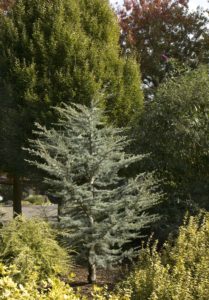
Cedrus atlantica ‘Horstmann’
Blue-gray foliage • 8–15′ tall • 5–6′ wide
A semi-dwarf specimen with icy blue foliage and sculptural, architectural branching. The perfect “Charlie Brown tree” in a container.

Magnolia grandiflora ‘Little Gem’
Glossy evergreen foliage • 15–20′ tall • 7–10′ wide
A compact form of Southern magnolia with a naturally pyramidal shape that works beautifully as a porch or patio “living Christmas tree” or to match your magnolia holiday wreath! After a brief indoor display, plant in full sun to part shade where it offers year-round evergreen structure, beautiful copper-backed leaves, and fragrant summer blooms.
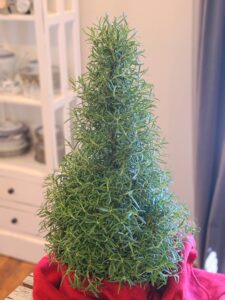
Salvia rosmarinus
Dark green foliage • 3–4′ tall • 2–3′ wide
Not long-term indoors, but fantastic as a gift-sized tabletop “tree.” Needs strong light and minimal water. Plant outside ASAP for year-round culinary harvests.
Subscribe now for the latest news and first access to upcoming events.

ADDRESS:
12804 Pelzel Rd Pilot Point TX 76258
*Located off FM 455, about halfway between Celina and Pilot Point
CALL: 972.954.8580
TEXT: 972.954.8574

HOURS:
Tuesday – Saturday 9 AM – 5 PM
Sunday 10 AM – 5 PM
CLOSED Wednesday, 12/24 through Monday, 1/5. Reopening on 1/6.
Subscribe now for the latest news and first access to upcoming events.